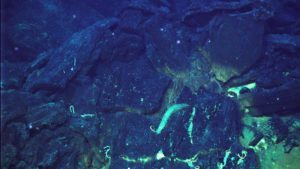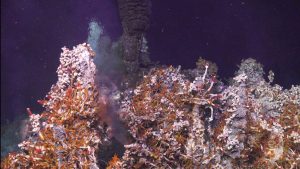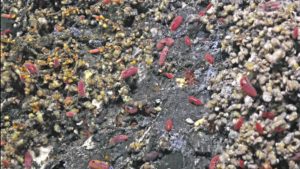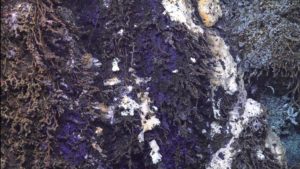We have spent the last two days diving at Axial Seamount, 300 miles off the coast of Oregon and Washington and nearly a mile beneath the waves. This volcano is the largest and most active underwater volcano off our coast having erupted in 1998, 2011, and 2015 – it is poised to erupt again.
Axial exhibits an astounding landscape with remanent, anastomosing lava channels from past eruptions that cut across the caldera, huge collapse pits with beautiful columns and glass covered arches where there were once lakes of molten lava, and skylights providing glimpses into the subsurface rarely seen by humans. This is a dark landscape with whirlpools of jet black lava, frozen in place as the molten rivers flowed across prior lava flows. Piles of glass covered talus at the bottom of collapsed pits mark where the frozen roof of lava lakes have collapsed as lava drained out elsewhere, leaving bathtub rings in its wake. Here, sea cumbers and brittle stars dot the flows and more rarely an octopus is seen likely searching for food.
As Jason makes its way along this stark, ever-changing landscape, in places like the ASHES and International Hydrothermal Fields, the vehicle is met by 2-18 m tall metal sulfide edifices, some nearly completely covered in strange life forms that make there living on microbes utilizing gases coming of the magma reservoir 2 km beneath the seafloor. Here, at pressures 150 times those on land, 350°C fluids issuing from many of the chimneys are boiling. Carbon dioxide-rich bubbles stream upwards in the fluids that burst like those from a firehose, – such is the case as at the hydrothermal vents Escargot, Diva, and El Guapo (the handsome one) in the International District Hydrothermal Field.
The lights from Jason light up this startling seascape as the towers emerge from the darkness. The vehicles lights only reach ~ 30 ft through the surrounding darkness. As the vehicle drives through the water, the vents first appear as eerie, wraithlike forms. As Jason gets closer, however, views on the multiple monitors in the dimly lit control van are astounding in the amount of life that completely covers many of the chimneys and the vibrant colors in these oases of the deep.
Foot-long tubeworms with beautiful red plumes, issuing from their white tubes, wave in the “wind,” bathed in mixtures of warm nutrient-rich hydrothermal fluids and seawater. The worms are supported by symbiotic bacteria inside of them that process carbon and hydrogen sulfide. The red plumes provide essential nutrients and hosts hemoglobin that carrys oxygen. Beautiful sulfide worms often grow on new chimney growth, where they form metal sulfide crusts as they build their tubes. At cooler conditions, palmworms are commonly intergrown with thousands of small limpets. Red scale worms, only about an inch in length are reminiscent of sow bugs and are mobile scavengers. They have small beaks and fat tongues that they use to munch on the red tubeworm plumes.
One of the most startling, yet beautiful sites are beautiful deep blue colonies of single celled protists that form thick patches on the chimneys. The team could spend hours wandering among the hydrothermal vents and even longer gazing at the phenomenal life forms that they host.
On Leg 3, we will share this extreme environment with you again as we return to the volcano.

A sea cucumber crawls across a glassy flow in Axial Caldera. Credit: UW/NSF-OOI/WHOI; J2-1613; V24.

The summit of Inferno is home to tubeworms, sulfide, palm and scale worms and thousands of small limpets. Credit: UW/NSF-OOI/WHOI; V24.

A colony of red scale worms (~ 1 inch long) thrive on the side of Inferno. Credit:UW/NSF-OOI/WHOI;V24.

Blue ciliates colonize the Inferno vent Two small sea spiders are crawling over them. Credit: UW/NSF-OOI/WHOI; J2-1613; V24.
Recent Updates